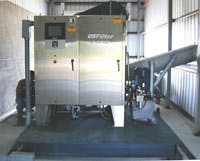Also booming are the challenges for Regional Utilities of Walton County, operated by Florida Community Services Corp. Now due to the growing population, the flow rates to Regional Utilities' three wastewater treatment plants have permanently increased by 15% each year in recent years. With these greatly increased wastewater flows the utility has struggled to keep up with drying and disposing of its digested sludge.
Three activated sludge plants in Sandestin, Point Washington and Seacrest provide wastewater treatment. In two of these facilities, Omniflo Sequential Batch Reactor (SBR) from USFilter Jet Tech Products is used, specifically, at the Point Washington and Seacrest plants.
An SBR plant performs flow equalization, biological treatment and secondary clarification sequentially in a single reactor tank. The SBR provides a high quality effluent for water reuse or irrigation.
The effluent from these Regional Utilities plants is used entirely and exclusively for irrigation while no effluent is discharged to natural water outlets.
Sludge-dewatering challenge
Walton County's continual growth places a large burden on the treatment plants, especially their sludge drying beds.
Why not add more drying beds? Regional Utilities looked at that option but decided against it for several reasons.
First, "cleaning sand beds is labor intensive," said Marell. Second raised by Marell was that rain is a continual problem especially in the summer.
"But the main consideration," Marell said, "was simply the amount of land you had to take up for more drying beds. At Sandestin we would have had to build 15 to 20 more beds to keep up. Down here an acre of land can cost $6 million."
They also considered land applying their sludge.
"They dispose of the sludge 80 miles from here. You'd be paying them to haul 98% water. From a cost standpoint that's not very feasible," added Marell.
After looking at all of the options Regional Utilities found their answer. "One centrifuge and its building takes up less space than half of one drying bed," said Marell.
Finding the answer
As part of their 2003 upgrade of the Point Washington plant Regional Utilities ordered the first of three skid-mounted Centrapac centrifuge dewatering systems from USFilter. Centrapac is completely prefabricated and pre-engineered for operation. After initial set up the centrifuge automatically adjusts to achieve maximum cake solids.
The first centrifuge has operated for nearly a year now. It operates 3-4 days a week for 8-10 hours at a time.
"We feed the sludge between 65 to 75 gpm," said Marell. "We're able to achieve 18% dry solids. It couldn't be easier. It's all automated. The operators turn it on and walk away. They'll come back about every hour just to check on it. Other than that it runs itself. They turn it off manually and then the unit goes into automatic back wash and shuts down itself."
A second centrifuge has begun operating at the Point Washington plant and a third one is on order for Seacrest.


